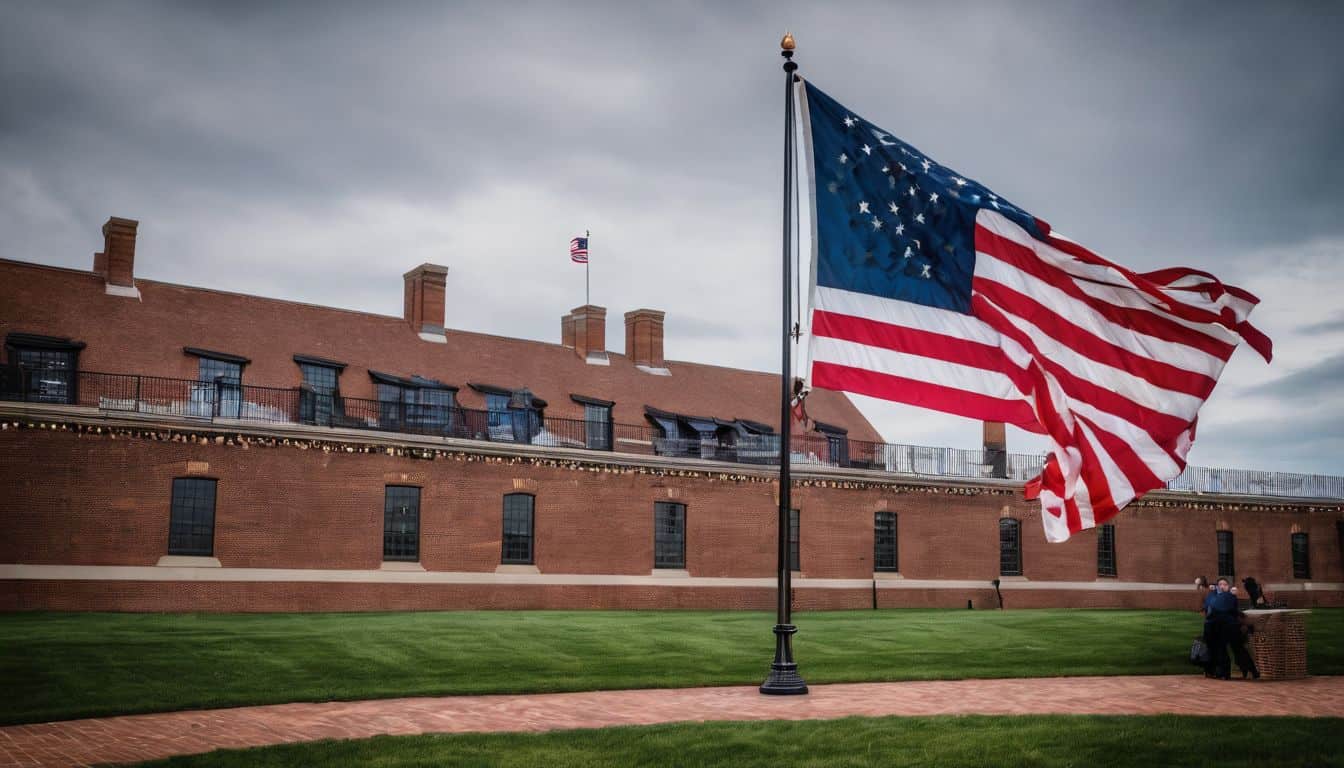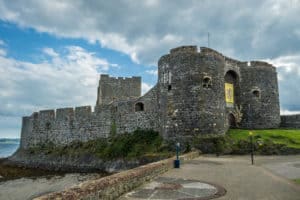The Defining Moment: The Battle of Baltimore in the War of 1812

Updated On: April 24, 2024 by Fatma Mohamed
Have you ever pondered the turning point in the War of 1812, “The Battle of Baltimore”, and felt overwhelmed by the maze of historical events? Fear not, for we are about to journey into the heart of this fascinating epoch, focusing on this pivotal moment.
In the upcoming paragraphs, we will navigate through the complexities of September 1814. We will unveil essential battle strategies, outcomes, and the remarkable birth of ‘The Star-Spangled Banner.’ So, settle into a cosy chair, indulge in your favourite brew, and join us on this captivating historical adventure. Ready to explore together, are we?
Key Takeaways
- The Battle of Baltimore in the War of 1812 was a significant conflict between British and American forces. The city of Baltimore played a central role.
- Both sea and land invasions were attempted, with Fort McHenry being bombarded by British troops. Still, ultimately, the American forces successfully repulsed the attack.
- Baltimore’s successful defence showcased American strength and resilience against foreign aggression.
- The battle inspired Francis Scott Key, who wrote “The Star-Spangled Banner,” which became America’s national anthem.
The Battle of Baltimore in the War of 1812
The Battle of Baltimore in the War of 1812 was a pivotal conflict between British and American forces. The port city of Baltimore played an important role. Both sea and land invasions were attempted, with Fort McHenry being bombarded by British troops. Still, ultimately, the American forces successfully repulsed the attack.
Background and Opposing Forces
The Battle of Baltimore was a big fight in the War of 1812. It occurred between British and American troops from September 12-14, 1814. The city of Baltimore was critical in that time.
Many people lived here and made money by trading goods. The fight happened on both land and sea. On one side, the American forces were ready to defend their homes and city. On the other side were British soldiers who wanted to seize Baltimore for their gains. Both sides had strong men with brave hearts ready for battle.
The Battle of North Point and Hampstead Hill
American forces defended Baltimore against a British land invasion in the Battle of North Point and Hampstead Hill. It was part of the more significant Battle of Baltimore during the War of 1812.
The British troops, which General Robert Ross led, aimed to capture Baltimore and weaken American morale. However, they faced strong resistance from Maryland militia and local volunteers.
Although General Ross was killed in action, the British eventually withdrew due to heavy casualties and fierce opposition. This successful defence boosted American confidence and paved the way for their victory at Fort McHenry.
The Bombardment of Fort McHenry and Aftermath
In the War of 1812’s Battle of Baltimore, the Bombardment of Fort McHenry stood out. British forces fiercely attacked the fort, aiming to seize control of Baltimore. Yet, American troops defended with unwavering determination against the intense assault that lasted over 25 hours.
Although enduring a relentless bombardment, Fort McHenry held firm, never falling into enemy hands. This pivotal moment had significant outcomes. Some of these are the inspiration behind “The Star-Spangled Banner.” Witnessing the fort’s resilient defence, Francis Scott Key penned a poem that evolved into America’s national anthem.
The battle wasn’t just a local affair; it showcased Baltimore’s strategic importance as a critical port city.
Baltimore successfully defended against British sea and land attacks and proved its strength and resilience.
Looking at the broader picture, the Battle of Baltimore left a lasting impact on American and British history. It dealt a severe blow to British morale and displayed American military prowess globally, strengthening alliances and shaping history.
The Significance and Legacy of the Battle of Baltimore
The Battle of Baltimore had a significant impact on both American and British history. It is the inspiration behind the writing of “The Star-Spangled Banner”. It showcases the resilience and determination of the American forces in defending their city.
Inspiration for “The Star-Spangled Banner”
American forces successfully defended the fort from a British bombardment during the Battle of Fort McHenry. This victory motivated Francis Scott Key to write “The Star-Spangled Banner,” which would later become the United States’ national anthem.
The song captures the resilience and bravery displayed by American troops during this battle. Since then, it has become an enduring symbol of American patriotism. The Battle of Baltimore and its role in inspiring our national anthem is a significant piece of American history that continues to be celebrated today.
The Importance of Baltimore in the War of 1812
Baltimore, a vital port city, played a crucial role in the War of 1812. Both British and American forces recognised its strategic significance. The Battle of Baltimore, a testament to resilience, showcased the determination of a young United States.
This historic battle marked a turning point, as the defeat of the British became a defining moment in American history. Maryland’s brave militia fought in the Battle of North Point before Baltimore, demonstrating unity and courage among its citizens.
The significance of Baltimore in the War of 1812 cannot be underestimated. It symbolised America’s unwavering strength and determination in defending its land against foreign invasion.
Impact on American and British history
The Battle of Baltimore had a significant impact on both American and British history. For the Americans, it was a moment of great pride and triumph. The successful defence of Fort McHenry and the city of Baltimore boosted the morale of the young nation during the War of 1812.
It restored their confidence and showed they could stand against a powerful enemy like Britain. The battle also inspired Francis Scott Key to write “The Star-Spangled Banner.” It eventually became the national anthem of the United States.
On the other hand, this defeat was a significant blow to the British’s military reputation. It showcased their failure to capture one of America’s major ports. It demonstrated their inability to achieve victory in this war.
This event marked a turning point in British strategy during the War of 1812, shifting focus away from direct attacks on American cities.
Baltimore: Where Charm Meets Grit
Baltimore, the “Charm City,” pulsates with a vibrant energy as captivating as its history. This iconic American city blends its proud industrial past with a booming arts and culture scene, offering visitors an unforgettable experience.
Baltimore’s Significance
- Strategic Port: Since the 1700s, Baltimore has been a crucial port city, shaping the nation’s trade and economy. Its strategic location on the Chesapeake Bay continues to make it a vital hub for commerce.
- Cultural Melting Pot: Baltimore boasts a rich tapestry of cultures, evident in its diverse neighbourhoods, vibrant festivals, and delicious cuisine. Each district tells a unique story, from Italian Little Italy to the African-American heritage of Hollins Market.
- Birthplace of Innovation: As the birthplace of the National Anthem and the legendary Edgar Allan Poe, Baltimore has fostered a legacy of creativity and innovation. It continues to be a hub for startups and groundbreaking research institutions.
Famous Landmarks
- Fort McHenry: Witness the star-spangled history of the fort that inspired the national anthem. Stand on the battlements where the American flag held strong during the War of 1812.
- Inner Harbour: Explore this waterfront haven, teeming with restaurants, shops, and attractions. Set sail on a harbour cruise, visit the National Aquarium, or marvel at the USS Constellation, a historic warship.
- Baltimore Museum of Art: Immerse yourself in world-class art collections spanning centuries and diverse cultures. This museum caters to every art lover, from ancient Egyptian artefacts to modern masterpieces.
What Makes Baltimore Famous for Tourists
- Food Lovers Paradise: You will be appreciated when you savour Maryland’s signature crab cakes and indulge in the iconic Berger cookies. Explore diverse culinary delights from around the globe. Baltimore’s food scene is a treat for every taste bud.
- Live Music Capital: Immerse yourself in the city’s vibrant music scene and leave yourself feeling the rhythm. Catch a renowned artist at the renowned Meyerhoff Symphony Hall and discover local talents in cosy jazz clubs.
- Outdoor Adventures: Embrace nature’s beauty in Baltimore’s green spaces. Hiking or biking through the serene trails of Druid Hill Park is an adventure that deserves your time. You can also kayak through the Inner Harbour. Enjoying a picnic overlooking the scenic waterfront is another option.
Baltimore is a city that surprises and delights. From its rich history and vibrant culture to its mouthwatering food and stunning scenery, there’s something for everyone to discover. So, pack your bags and prepare to be charmed by Baltimore’s unique blend of grit and glamour!
Conclusion
The Battle of Baltimore in the War of 1812 reverberates in history books and the American spirit. It was a defining moment for the United States. It served as a testament to the unwavering courage of those who defended Fort McHenry and a reminder that hope and resilience prevail even in the face of adversity.
Today, the echoes of Fort McHenry continue to inspire, reminding us of the strength that comes from unity and the unyielding determination that defines the American spirit.
FAQs
Why was the Battle of Baltimore so important?
The Battle of Baltimore held immense symbolic importance. It boosted American morale and showcased their resilience against a powerful foe. It inspired the iconic anthem that still unites the nation today.
Who won the Battle of Baltimore?
The American Forces defeated the British. It was a port and land battle and showcased the courage of the Americans.
Who was the Commander of the invading British forces?
During this battle, Robert Ross was Commander for Britain’s side, while Major General Samuel Smith fought for America.
Can you tell me about some battle tactics used there?
Both sides used different tactics, such as enclosing movements and strong defences from all directions, which shaped how they fought each other on land and sea.






